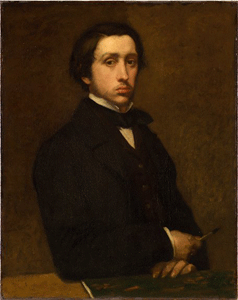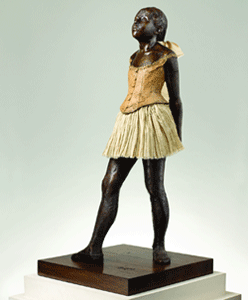|
Little Dancer - Edgar Degas
Petite Danseuse de Quatorze Ans
Answer
to Name
This Famous Antique Game - January 2017
By Mike McLeod

Edgar Degas, the famous painter, was also a sculptor. The masterpiece featured here is his Petite Danseuse de Quatorze Ans (Little Dancer of Fourteen Years). Originally created in wax and standing about three feet high, more than two dozen bronzes were created from the original after Degas’ passing on September 27, 1917. One of those sold in 2015 for almost $25 million at Sotheby’s.
|

|

|
|
Edgar Degas, 1855.
|
Degas’ Petite Danseuse de Quatorze Ans (Photo: M.T. Abraham Center)
|
This seemingly unassuming, straightforward sculpture created a firestorm when it was first exhibited in Paris in 1881. The critiques were across the spectrum. The harshest of which labeled the Little Dancer—the sculpture and the young model—as vulgar. Today, realistic sculpture is accepted and appreciated. Realism in art, which began in 1840, was still not widely accepted at the time of Degas in the latter 1800s. Why? The Art Story explains on its website: “Realist painters replaced the idealistic images and literary conceits of traditional art with real-life events, giving the margins of society similar weight to grand history paintings and allegories.”1 For many at that time, Degas’ sculpture was just too real.
Degas shocked the art society not only by realistically portraying a young ballet dancer in training, but also by dressing the sculpture in real clothes. He placed a tutu, a bodice and even a wig on the work and then covered those pieces with wax. The use of wax as a medium for the sculpture itself was also radical and shocking for that time. Fine art was supposed to be lofty in its subject matter. However, Degas chose to bring it down to earth.
Young girls in training to be ballet dancers were referred to as “rats,” or “petite rats,” perhaps because many came from the working classes, the gutter-side of society, with hopes of clawing their way up to become famous and rich ballerinas. The ballet schools that trained them could be likened to the old school Marine Corps’ boot camp—extremely rigorous in discipline, strenuous exercises, insulting belittlement, and living with pain. Training to be a ballerina was not a tea party.
At that time, ballet dancers were rock stars. Critiques of their performances and the trials of their profession were often published in newspapers and avidly followed by Parisian society, just as baseball, football and basketball players are scrutinized in today’s media.2
Degas chose young Marie Van Goethem as the model for his sculpture. Byron’s Muse Blog writes of her: “Certain critics compared the dancer to a monkey and to Aztecs. One critic, Paul Mantz, called her the ‘flower of precocious depravity,’ with a face ‘marked by the hateful promise of every vice’ and ‘bearing the signs of a profoundly heinous character.’ Degas had exhibited the sculpture inside a glass case, and the audience reported that it looked like a medical specimen.”3 Mantz also wrote that the sculpture “…is nearly terrifying….”4
To be fair, some critics were enthralled with his work, as are most collectors of art today. However, one must wonder how the negative reaction affected him; this was the only sculpture Degas ever exhibited in public during his lifetime.5
Edgar Degas was born in Paris on July 19, 1834. The subjects of more than half of his artwork were ballerinas and dancers. Degas never married, unless you count be married to his work as an artist. In addition to painting, sculpture and printmaking, he was also an early experimenter in photography. Unfortunately, Degas’ eyesight was poor, and toward the end of his life, he was nearly blind—which could also be said of many of the critics of his Petite Danseuse de Quatorze Ans.
The Little Dancer was correctly identified by Ted Carlton of Utah who reads Southeastern Antiquing Magazine at www.antiquingmagazine.com.
--------------------------------------------------
1 Theartstory.org, “Realism.”
2 Criticsatlarge.ca, Excerpt from Ballerina: Sex, Scandal, and Suffering Behind the Symbol of Perfection by Deirdre Kelly, October 3, 2012.
3 Byron’s Muse, byronsmuse.wordpress.com.
4 Sotheby’s Impressionist & Modern Art Evening Sale, June 24, 2015, catalog note for lot 14, Petite Danseuse de Quatorze Ans.
5 Nga.gov, “Degas, Edgar.”
Uncredited photo, public domain, PD-US.
Credit: Wikipedia.org.
|